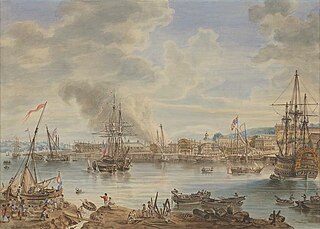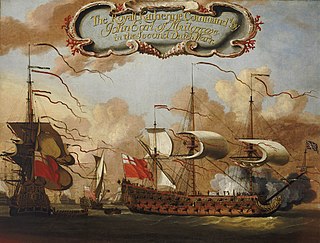
Harwich is a town in Essex, England, and one of the Haven ports on the North Sea coast. It is in the Tendring district. Nearby places include Felixstowe to the north-east, Ipswich to the north-west, Colchester to the south-west and Clacton-on-Sea to the south. It is the northernmost coastal town in Essex.

Woolwich Dockyard was an English naval dockyard along the river Thames at Woolwich in north-west Kent, where many ships were built from the early 16th century until the late 19th century. William Camden called it 'the Mother Dock of all England'. By virtue of the size and quantity of vessels built there, Woolwich Dockyard is described as having been 'among the most important shipyards of seventeenth-century Europe'. During the Age of Sail, the yard continued to be used for shipbuilding and repair work more or less consistently; in the 1830s a specialist factory within the dockyard oversaw the introduction of steam power for ships of the Royal Navy. At its largest extent it filled a 56-acre site north of Woolwich Church Street, between Warspite Road and New Ferry Approach; 19th-century naval vessels were fast outgrowing the yard, however, and it eventually closed in 1869. The former dockyard area is now partly residential, partly industrial, with remnants of its historic past having been restored.

Chatham Dockyard was a Royal Navy Dockyard located on the River Medway in Kent. Established in Chatham in the mid-16th century, the dockyard subsequently expanded into neighbouring Gillingham.

Royal Charles was an 80-gun first-rate three-decker ship of the line of the English Navy. She was built by Peter Pett and launched at Woolwich Dockyard in 1655, for the navy of the Commonwealth of England. She was originally called Naseby, named in honour of Sir Thomas Fairfax's decisive 1645 victory over the Royalist forces during the English Civil Wars. She was ordered in 1654 as one of a programme of four second rates, intended to carry 60 guns each. However, she was altered during construction to mount a complete battery of guns along the upper deck, and so was reclassed as a first rate.

HMS Royal Katherine was an 84-gun full-rigged second-rate ship of the line of the Royal Navy, launched in 1664 at Woolwich Dockyard. Her launching was conducted by Charles II and attended by Samuel Pepys. Royal Katherine fought in both the Second and Third Anglo-Dutch Wars and afterwards, the War of the Grand Alliance before entering the dockyard at Portsmouth for rebuilding in 1702. In this rebuilding, she was upgraded to carry more guns, 90 in total, and served in the War of the Spanish Succession during which she was renamed Ramillies in honour of John Churchill's victory at the Battle of Ramillies. She was rebuilt again in 1742–3 before serving as the flagship of the ill-fated Admiral John Byng in the Seven Years' War. Ramillies was wrecked at Bolt Tail near Hope Cove on 15 February 1760.

Royal Navy Dockyards were state-owned harbour facilities where ships of the Royal Navy were built, based, repaired and refitted. Until the mid-19th century the Royal Dockyards were the largest industrial complexes in Britain.

His Majesty's Naval Base, Portsmouth is one of three operating bases in the United Kingdom for the Royal Navy. Portsmouth Naval Base is part of the city of Portsmouth; it is located on the eastern shore of Portsmouth Harbour, north of the Solent and the Isle of Wight. For centuries it was officially known as HM Dockyard, Portsmouth: as a Royal Dockyard, Portsmouth functioned primarily as a state-owned facility for building, repairing and maintaining warships; for a time it was the largest industrial site in the world.
HMS Royal Oak was a 100-gun first rate ship of the line of the Royal Navy, launched in 1664 at Portsmouth Dockyard. Royal Oak was built by John Tippetts, Master-Shipwright at Portsmouth 1660-8, who later became Navy Commissioner and subsequently Surveyor of the Navy.

Sir Anthony Deane, FRS was an English shipwright and politician who sat in the English House of Commons and served as mayor of Harwich.

HMS Royal James was a 102-gun first rate ship of the line of the Royal Navy, built by Anthony Deane at Portsmouth Dockyard at a cost of £24,000, and launched on 31 March 1671.

Bombay Dockyard, also known as Naval Dockyard, is an Indian shipbuilding yard at Mumbai. The superintendent of the dockyard is a Naval Officer of the rank Rear Admiral, known as the Admiral Superintendent.
Edmund Dummer (1651–1713) was an English naval engineer and shipbuilder who, as Surveyor of the Navy, designed and supervised the construction of the Royal Navy dockyard at Devonport, Plymouth and designed the extension of that at Portsmouth. His survey of the south coast ports is a valuable and well-known historic document. He also served Arundel as Member of Parliament for approximately ten years and founded the first packet service between Falmouth, Cornwall and the West Indies. He died a bankrupt in the Fleet debtors' prison.

Deptford Dockyard was an important naval dockyard and base at Deptford on the River Thames, operated by the Royal Navy from the sixteenth to the nineteenth centuries. It built and maintained warships for 350 years, and many significant events and ships have been associated with it.
Rosebush was a vessel of the British Navy and is named as one of his Majesty's ships in 1660, commissioned by James, Duke of York who at that time was commander of the Royal Navy.
Kinsale Dockyard was a British Royal Navy base located at Kinsale, Ireland from c. 1647 to 1812.
HMS Fanfan was built by Anthony Deane during his tenure as the Master Shipwright at Harwich Dockyard under the 1665 Programme.. While the vessel was commissioned as a sixth rate, she was actually a yacht built for Prince Rupert and allegedly named after the pet-name of one of his lady friends. The vessel was more along the lines of a ketch than a sixth rate vessel. It saw action during the Battle of Oxfordness 1666. Then the Mediterranean before being sent to Ireland and Scotland. She was converted to a pitch boat in either 1692 or 1693.
HMS Truelove started her career as the Royalist 14-gun Katherine during the English Civil War. She was captured by the 'Irish Squadron' of the Parliamentary Forces in early 1647, then purchased for 75.1.02d and fitted for service at Bristol. She was commissioned in 1648, joined the Royalists then surrendered in November 1648 to Parliament. In the Commonwealth Navy she spent her time patrolling, as a guardship, moving troops. After the restoration of the monarchy, she was converted to a fireship and expended at the Battle of Texel in 1673.
HMS Nightingale was a development of the standardize 20-gun sixth rates and were built at the beginning of the 18th Century. After she was captured by French privateer galleys in 1707 then recaptured four months later. She was renamed HMS Fox and continued service until she was rebuilt at Deptford. Her breaking was completed in January 1738.

William Castle or Castell of Rotherhithe (c.1615–1681) was a shipbuilder for the Royal Navy and occasionally for the East India Company. He is mentioned more than once in the Diary of Samuel Pepys.
John Barnard (1705–1784) was an 18th century English shipbuilder serving the Royal Navy.











